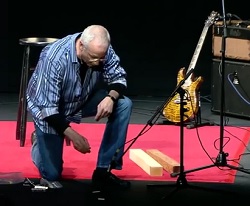Paul Reed Smith shared his interesting “Subtractive Theory” on guitar design at the TEDxMidAtlantic 2013 event.

Related Feature:
Electric Guitar Wood Myth Busted?
Paul’s talk that has a bold claim for a title, “Changing Your View of Musical Instruments”, is now available on TEDxTalks’ YouTube channel.
His presentation revealed his ideas on musical instrument sound production, which are applied to how his company makes guitars.
At the start of the talk, Paul had a big claim, and that is to change our view of the electric guitar! This is big considering that he is addressing guitar players that have probably heard it all! But his claim may be substantial because his “Subtractive Theory” is a stark contrast to all the marketing hype on how certain guitars or guitar parts “add something” to the final sound.
Basically, he is saying that nothing is added to the sound, rather the instruments subtracts. He says that despite all the magic hype, all musical instruments are subtractive devices, and the less they subtract the better they sound. He even pointed to a paraphrased version of Isaac Newton’s third law: “For every action there is an equal and opposite reaction”, and he suggested that the goal is to subtract as less as possible. He championed that the PRS guitar design follows this philosophy, utilizing parts that do not hinder the sonic energy from the player.
” I’m suggesting that if you put a better bridge on a guitar, it’s not that it adds to the sound, it subtracts less. I live in a Newtonian physics world. The goal is an energy of 6 in and 5.9 out. That would be a really great instrument. It makes a difference what the materials are. “
Paul Reed Smith
Watch the entire Paul Reed Smith talk below:
Smith made some convincing experiments comparing different types of nuts and bridges and displaying how resonant certain materials are. His emphasis on the nut, bridge and strings confirm what we noted in the controversial “Electric Guitar Wood Myth Busted” article we published a while back: “string setup, pickup type and pickup placement is what causes the various tonal differences that we hear between electric guitar models and brands”. Unfortunately Paul did not show any experiment to showcase the effect of wood on PRS electric guitars, I was totally waiting for him go into detail because he did hint at the effect of tonewoods and glue at the start of his talk!
He did however showcase the resonance and sustain of a PRS acoustic guitar on stage. He even tried to use his picking arm to mute the top resonance and show how subtracting from the resonance affected the sound.
Paul ends his presentation by playing a high-gain electric guitar rendition of the Star-Spangled Banner. A nice take away from this talk would be Paul’s comment that although the fundamentals in producing tone are simple, the secrets to unlocking highly musical sound and the application of those methods can take a lifetime.
Related Article:
PRS is part of our Best Electric Guitar Brands list!


I totally agree. Adding a FloydRose will subtract from the sound as most of the sting energy is deflected back to the sting rather than to the body of the guitar.
The best sounding Martins are the simple D-18’s.